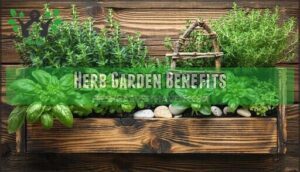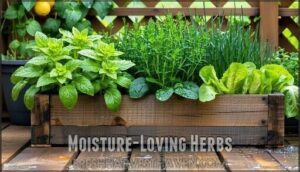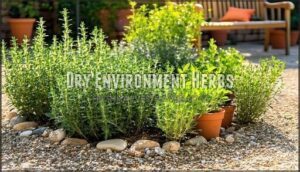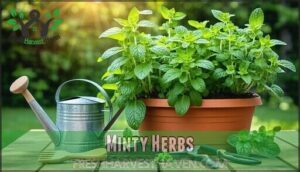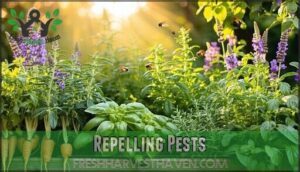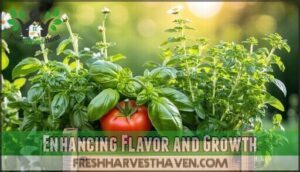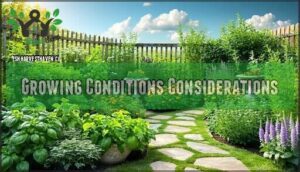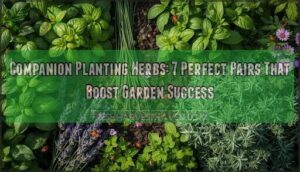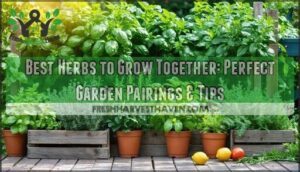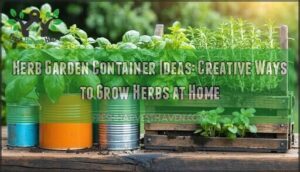This site is supported by our readers. We may earn a commission, at no cost to you, if you purchase through links.
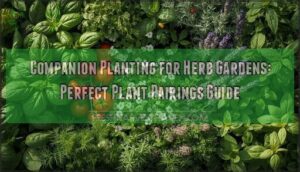
Lavender creates aromatic harmony with rosemary, thyme, and sage, while lemon balm near tomatoes deters cabbage moths and attracts beneficial pollinators. These smart pairings can reduce your need for chemical treatments by up to 80%. The secret lies in understanding which herbs complement each other’s growing needs and natural defense systems, utilizing natural pest control and resulting in enhanced flavors.
Table Of Contents
- Key Takeaways
- Choosing Herb Companions
- Herb Garden Benefits
- Planting Herb Categories
- Companion Planting Techniques
- Growing Conditions Considerations
- Frequently Asked Questions (FAQs)
- What is the mother of all herbs?
- What herbs should not be planted next to each other?
- What plants go well with herbs?
- Which herbs to plant together chart?
- What vegetables and herbs can be planted together?
- Can companion plants affect herb seed germination?
- What herbs grow well near fruit trees?
- How does wind exposure impact herb companions?
- Are there herbs suited for vertical gardening?
- Which herbs deter rodents or larger pests?
- Conclusion
Key Takeaways
- You’ll create natural pest control by pairing herbs like basil with tomatoes and cilantro with dill, reducing your need for chemical treatments by up to 80%.
- You’ll maximize garden space and boost flavors through strategic combinations like rosemary with thyme or lavender with sage that share similar growing requirements.
- You’ll attract beneficial pollinators and improve soil health when herbs like lemon balm near tomatoes deter pests while drawing in helpful insects.
- You’ll ensure success by grouping herbs with similar water and light needs, like moisture-loving mint with chives or drought-tolerant Mediterranean herbs together.
Choosing Herb Companions
Selecting the right herb companions transforms your garden into a thriving ecosystem where plants naturally support each other’s growth and health.
You’ll discover that strategic pairings like basil with oregano or rosemary with thyme create powerful partnerships that boost flavor, repel pests, and maximize your garden space.
Basil Companion Plants
You’ll find basil thrives alongside tomatoes, peppers, and oregano – creating natural pest deterrence while boosting flavor enhancement.
These companion planting strategies offer growth support through improved soil conditions.
Chives and marigolds provide excellent basil pairings for space optimization in herb gardens.
Plant companions like beans add nitrogen, supporting your basil’s leafy development perfectly, which is a great example of natural pest deterrence.
Cilantro Companion Plants
Cilantro transforms your herb garden into a pest-fighting powerhouse while boosting neighboring plants’ growth and flavor.
Turn your garden into nature’s pest control system with strategic cilantro companions.
This versatile herb offers multiple companion planting benefits that’ll revolutionize your gardening approach.
- Dill partnership – Promotes cilantro growth while repelling aphids and spider mites from garden beds
- Parsley pairing – Shares similar watering needs, reducing care complexity and improving plant health
- Chives combination – Deters aphids and leaf miners, creating natural pest control around cilantro
- Tarragon teamwork – Boosts cilantro’s flavor and resilience when grown together
Lavender Companion Plants
Lavender varieties thrive alongside Mediterranean herbs like rosemary, thyme, and sage, creating fragrant harmony in your garden.
These companion vegetables and herbs share similar soil preferences for well-drained conditions. Rose pairings with lavender offer stunning visual contrast while maintaining compatible growing needs.
This companion planting guide maximizes aromatic benefits through strategic herb pairings that support healthy garden companions. Companion planting also aids in pollination by attracting beneficial insects, which is a key aspect of companion planting and helps in creating a healthy garden.
Lemon Herbs Companion Plants
Lemon herbs like lemon balm and lemon verbena make excellent companion plants.
Lemon balm pairings work well with tomatoes and brassicas, deterring cabbage moths while attracting pollinators.
Lemon verbena benefits from growing alongside basil and rosemary.
These citrus herb combinations create natural pest control systems, repelling aphids and whiteflies through their strong aromatics.
Lemon balm also enhances gardens by attracting beneficial insects, which is a key aspect of companion planting.
Herb Garden Benefits
When you pair herbs strategically in your garden, you’ll activate a natural system that works harder than any single plant alone.
These plant partnerships create sustainable growing conditions that reduce your need for chemicals while boosting your garden’s overall health and productivity.
Benefits of Sustainable Practices
Companion planting herbs creates a ripple effect of environmental benefits that’ll transform your garden into an eco-friendly powerhouse.
You’ll reduce chemical use by 80% when herbs naturally repel pests and diseases.
Water conservation becomes effortless as deep-rooted companions share moisture efficiently.
Biodiversity increase happens organically through pollinator-attracting blooms and beneficial insect habitats.
Soil enrichment occurs naturally through nitrogen-fixing partnerships and organic matter cycling.
Waste reduction follows as healthy plants need fewer replacements, making sustainable practices both economical and environmentally responsible, with eco-friendly methods, water conservation, biodiversity increase, and sustainable practices.
Improving Soil Health
Your herb combinations work together below ground, creating healthier soil through nutrient cycling and water retention.
Deep-rooted plants like rosemary bring up minerals, while shallow-rooted basil accesses surface nutrients.
This partnership feeds beneficial soil microbes that break down organic matter. You can further improve soil conditions with specific soil amendments.
The result? Better erosion control and improved soil structure that supports stronger, more resilient plants throughout your garden, leading to more resilient plants.
Attracting Pollinators
Your herb companions create a bustling pollinator paradise.
Mixed plantings boost pollinator visits by 30% compared to single-species gardens.
Basil flowers draw honeybees, while lavender attracts five times more bumblebees than non-flowering herbs.
Native bees thrive with indigenous species like bee balm.
Strategic herb clusters near vegetables increase pollination rates by 18%, creating essential nectar sources and butterfly gardens throughout your growing season.
Repelling Pests Naturally
Beyond attracting beneficial pollinators, your herb garden becomes a fortress against unwanted pests.
Basil’s volatile oils repel flies and mosquitoes, while rosemary’s strong scent reduces carrot root fly activity by masking host plant odors.
These aromatic pest control champions create natural insecticides that deter harmful insects without chemicals.
Strategic companion plant defenses boost herb pest resistance naturally.
Regular inspections are part of integrated pest management, which is a key component of organic herb garden maintenance.
Planting Herb Categories
Understanding your herbs’ growing preferences helps you create successful plant partnerships that thrive together.
You’ll group herbs by their water, light, and soil needs to guarantee each category gets exactly what it requires for healthy growth.
Moisture-Loving Herbs
Thriving in moist conditions, these herbs need consistent watering schedules and higher humidity needs than their drought-tolerant cousins.
Mint, lemon balm, and chives form excellent companion vegetables partnerships with lettuce and spinach. Container options work well since you can control moisture levels precisely.
These symbiotic relationships showcase companion planting benefits through shared water requirements. Herb seed availability can vary by season.
Propagation methods like division work perfectly for expanding your herb garden planning efforts.
Dry Environment Herbs
Mediterranean herbs like rosemary, thyme, and sage thrive in your driest garden spots.
These drought-tolerant plants excel in xeriscaping, requiring minimal water once established. Their deep roots access moisture others can’t reach.
You can find various drought-tolerant herb products. Plant these sun-loving herbs together in well-draining soil for natural water conservation and Mediterranean flair.
Lemon Herbs
Citrus-scented herbs bring bright flavors to your garden while offering natural pest control benefits.
These aromatic plants pair well with Mediterranean herbs and thrive in well-drained soil with full sun exposure.
- Lemon verbena and sorrel create fragrant combinations that enhance culinary dishes while supporting each other’s growth in sunny locations
- Lemon balm with mint forms invigorating herb garden pairings, though both need contained spaces to prevent aggressive spreading
- Lemon thyme with rosemary provides excellent companion planting tips for drought-tolerant gardens with enhanced essential oil production
Minty Herbs
Mint varieties spread aggressively through underground runners, making container cultivation ideal for herb garden pairings.
You’ll want to pair mint with oregano since they share similar growing conditions without competing. Mint propagation happens quickly, so regular harvesting prevents overwhelming neighboring plants.
These herbal pairings offer excellent companion planting benefits while controlling mint’s invasive nature through strategic placement and frequent use. Mint and lemon balm, for example, exhibit similar water needs making them ideal for containers, which helps in strategic placement and allows for frequent use.
Companion Planting Techniques
You’ll discover that strategic herb pairings create natural pest control systems while boosting the flavor and growth of your garden plants.
These companion planting techniques work by leveraging each herb’s unique properties to protect neighbors from harmful insects and enhance their essential oil production.
Repelling Pests
Your herb companions create a natural fortress against garden pests.
Transform your herb garden into nature’s own security system with strategic plant partnerships
Transform your garden into a pest-fighting powerhouse with strategic herb companions.
Basil’s volatile oils repel flies and aphids, while lavender’s linalool deters moths and beetles.
These aromatic repellents work through pest confusion, masking scents that attract unwanted insects.
Plant pairings like rosemary near carrots reduce root fly activity by disrupting their host-finding abilities, creating effective organic pest deterrents with natural fortress and aromatic repellents.
Enhancing Flavor and Growth
Boost your companion planting garden’s potential by pairing herbs strategically for nutrient synergy and aroma intensification.
Basil enhances tomato flavor profiles while oregano strengthens neighboring plant pairings through growth optimization.
These herb combinations create companion benefits that maximize your herb garden design’s flavor enhancement naturally.
Growing Conditions Considerations
Understanding your herb’s specific growing needs guarantees successful companion planting combinations that actually work together.
You’ll prevent common mistakes like pairing drought-loving Mediterranean herbs with water-hungry plants that compete for resources, which is crucial for the successful growth of your herbs.
Light Requirements
Understanding sunlight requirements transforms your herb garden companion planting success.
Different herbs thrive under specific light conditions, making proper placement essential for healthy growth.
- Full sun herbs (6+ hours daily): Rosemary, thyme, oregano, and sage need maximum sun exposure for maximum oil production
- Partial shade herbs (3-6 hours): Parsley, cilantro, and chives tolerate less direct sunlight while maintaining flavor
- Light duration needs vary seasonally – adjust companion groupings based on changing shadow patterns throughout growing seasons
- Artificial light options work indoors using LED grow lights with proper light spectrum effects for year-round cultivation
- Sun exposure planning prevents tall herbs from shading shorter companions in your herb garden sunlight layout
Water Requirements
How often should you water your companion planting herb garden?
Watering frequency depends on plant compatibility and individual watering needs.
Mediterranean herbs like rosemary show excellent drought tolerance, while basil requires consistent moisture.
Check drainage solutions to prevent overwatering signs like yellowing leaves.
Group herbs with similar humidity levels together.
Most herbs prefer deep, infrequent watering over frequent shallow drinks for ideal health.
Soil Requirements
Perfect soil sets your herb garden up for success. Most culinary herbs thrive in soil pH between 6.0-7.5, while Mediterranean varieties like lavender prefer alkaline conditions around 7.0-8.0.
Well-drained soil prevents root rot and boosts essential oil production. Sandy soils work great for rosemary and sage.
Improve heavy clay with compost or sand to enhance drainage matters. Container mixes need excellent aeration to prevent compaction affecting growth.
Harvesting and Maintenance Tips
Most herb garden maintenance revolves around smart pruning techniques and consistent soil monitoring. You’ll want to harvest morning herbs like chamomile early, while evening primrose waits until dusk. Regular garden sanitation prevents disease spread, and proper tool maintenance keeps cuts clean.
Don’t forget crop rotation principles—even herbs benefit from strategic placement changes to maintain soil health and maximize yields. Effective gardening also requires the right Herb Garden Tools to guarantee efficient care and harvesting, which involves understanding regular garden sanitation and applying proper tool maintenance.
Frequently Asked Questions (FAQs)
What is the mother of all herbs?
You’ll often hear parsley called the "mother of all herbs" because it’s incredibly versatile, pairs beautifully with nearly every other herb, and forms the foundation of countless culinary traditions worldwide.
What herbs should not be planted next to each other?
You shouldn’t plant mint near lavender, tomatoes, or parsley since mint’s aggressive spreading can overwhelm these delicate herbs.
Also avoid pairing fennel with most herbs as it inhibits their growth through allelopathic compounds.
What plants go well with herbs?
Vibrant vegetables and flourishing flowers create perfect partnerships with your herb garden. You’ll find tomatoes, peppers, carrots, and beans thrive alongside herbs, while marigolds, nasturtiums, and borage attract beneficial pollinators naturally.
Which herbs to plant together chart?
Create your herb garden companion chart by pairing Mediterranean herbs like rosemary with thyme, basil with oregano, and sage with lavender for ideal growth and pest control.
What vegetables and herbs can be planted together?
Imagine your garden where every plant works like a perfect team—that’s what happens when you pair vegetables with herbs strategically.
You’ll boost growth while deterring pests naturally through these powerful partnerships.
Can companion plants affect herb seed germination?
Yes, companion plants can substantially influence herb seed germination rates. Certain companions release root chemicals that either boost or inhibit germination, while others affect soil moisture, temperature, and nutrient levels around seeds.
What herbs grow well near fruit trees?
Fruit trees welcome certain green companions that’ll sweeten your harvest success.
You’ll find basil, chives, and mint create protective partnerships beneath branches, deterring pests while enhancing soil health and attracting beneficial pollinators naturally.
How does wind exposure impact herb companions?
Wind exposure affects your herb companions by creating stress that can weaken plants and reduce their protective benefits.
Sheltered herbs grow stronger, produce better essential oils, and provide more effective pest deterrence for neighboring plants, which can be achieved by minimizing wind exposure.
Are there herbs suited for vertical gardening?
Like climbing vines reaching toward sunlight, several herbs naturally ascend vertical surfaces.
You’ll find oregano, thyme, mint, and trailing nasturtiums excel in tower gardens, wall planters, and hanging systems with proper drainage and support.
Which herbs deter rodents or larger pests?
Mint, rosemary, and sage naturally repel rodents with their strong scents. Plant these aromatic herbs around garden borders or entry points where you’ve noticed pest activity for effective, chemical-free deterrence.
Conclusion
Mastering companion planting for herb gardens is like conducting a symphony where every plant plays its perfect note.
You’ll transform your garden into a thriving ecosystem that naturally protects itself while boosting flavors.
Your strategic plant partnerships will reduce pest problems, improve soil health, and create beautiful aromatic combinations.
Start small with proven pairs like basil-tomato or lavender-rosemary, then expand as you gain confidence in these powerful gardening techniques.
- https://extension.umn.edu/preserving-and-preparing/how-make-your-own-sauerkraut
- https://extension.arizona.edu/sites/extension.arizona.edu/files/attachment/CompanionPlantingApr2023.pdf
- https://ucanr.edu/blogs/blogcore/postdetail.cfm?postnum=17642
- https://www.gardeningknowhow.com/edible/herbs/hgen/companion-planting-in-your-herb-garden.htm
- https://homefortheharvest.com/people/about-mary-jane-duford/

